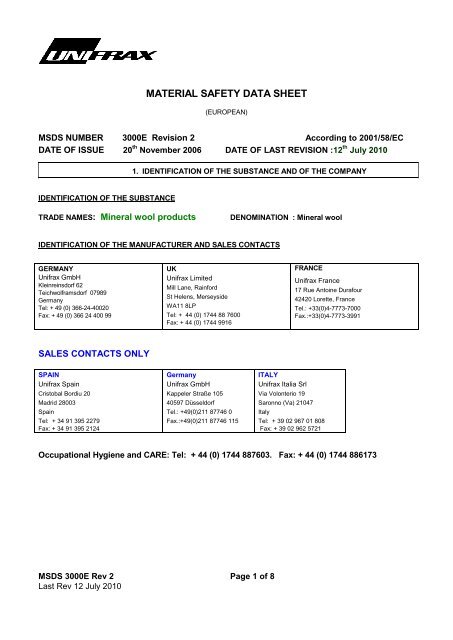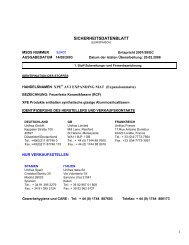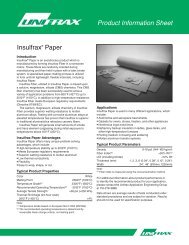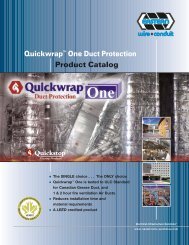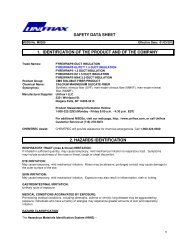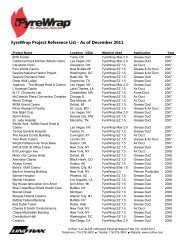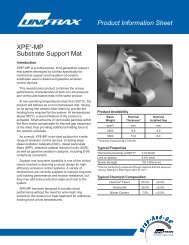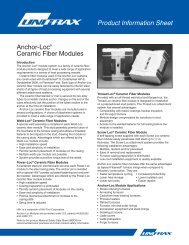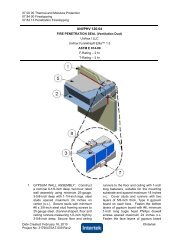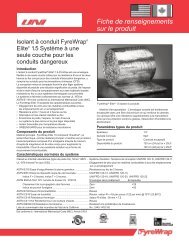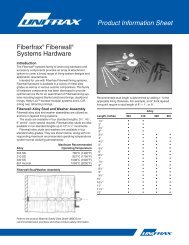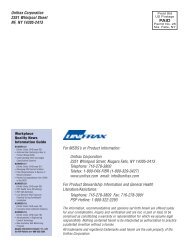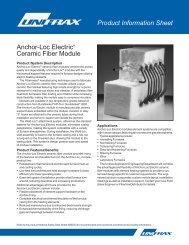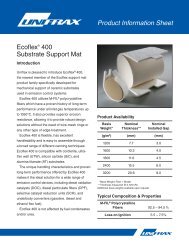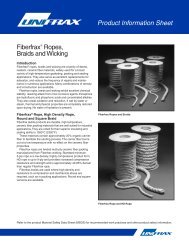Mineral Wool - Unifrax
Mineral Wool - Unifrax
Mineral Wool - Unifrax
You also want an ePaper? Increase the reach of your titles
YUMPU automatically turns print PDFs into web optimized ePapers that Google loves.
MATERIAL SAFETY DATA SHEET<br />
(EUROPEAN)<br />
MSDS NUMBER 3000E Revision 2 According to 2001/58/EC<br />
DATE OF ISSUE 20 th November 2006 DATE OF LAST REVISION :12 th July 2010<br />
IDENTIFICATION OF THE SUBSTANCE<br />
1. IDENTIFICATION OF THE SUBSTANCE AND OF THE COMPANY<br />
TRADE NAMES: <strong>Mineral</strong> wool products DENOMINATION : <strong>Mineral</strong> wool<br />
IDENTIFICATION OF THE MANUFACTURER AND SALES CONTACTS<br />
GERMANY<br />
<strong>Unifrax</strong> GmbH<br />
Kleinreinsdorf 62<br />
Teichwolframsdorf 07989<br />
Germany<br />
Tel: + 49 (0) 366-24-40020<br />
Fax: + 49 (0) 366 24 400 99<br />
SALES CONTACTS ONLY<br />
SPAIN<br />
<strong>Unifrax</strong> Spain<br />
Cristobal Bordiu 20<br />
Madrid 28003<br />
Spain<br />
Tel: + 34 91 395 2279<br />
Fax: + 34 91 395 2124<br />
UK<br />
<strong>Unifrax</strong> Limited<br />
Mill Lane, Rainford<br />
St Helens, Merseyside<br />
WA11 8LP<br />
Tel: + 44 (0) 1744 88 7600<br />
Fax: + 44 (0) 1744 9916<br />
Germany<br />
<strong>Unifrax</strong> GmbH<br />
Kappeler Straße 105<br />
40597 Düsseldorf<br />
Tel.: +49(0)211 87746 0<br />
Fax.:+49(0)211 87746 115<br />
MSDS 3000E Rev 2 Page 1 of 8<br />
Last Rev 12 July 2010<br />
ITALY<br />
<strong>Unifrax</strong> Italia Srl<br />
Via Volonterio 19<br />
FRANCE<br />
Saronno (Va) 21047<br />
Italy<br />
<strong>Unifrax</strong> France<br />
Tel: + 39 02 967 01 808<br />
Fax: + 39 02 962 5721<br />
17 Rue Antoine Durafour<br />
42420 Lorette, France<br />
Tel.: +33(0)4-7773-7000<br />
Fax.:+33(0)4-7773-3991<br />
Occupational Hygiene and CARE: Tel: + 44 (0) 1744 887603. Fax: + 44 (0) 1744 886173
2. COMPOSITION / INFORMATION OF INGREDIENTS<br />
COMPONENT CAS NUMBER SYMBOL R PHRASES<br />
COMPOSITION<br />
<strong>Mineral</strong> wool 287922-11-6 None None<br />
<strong>Mineral</strong> wool contains: 23-26% CaO-MgO, 18-23% Al2O3, 38-43% SiO2<br />
DESCRIPTION<br />
<strong>Mineral</strong> wool products are available in the form of: boards and shapes. According to product form, other<br />
ingredients may be present (see appended).<br />
Use of the product<br />
For application as thermal insulation at temperature up to 1000°C, in industrial process equipment, the domestic<br />
appliance industries and as passive fire protection systems and firestops.<br />
3. HAZARDS IDENTIFICATION<br />
Mild mechanical irritation to skin, eyes and upper respiratory system may result from exposure.<br />
These effects are usually temporary<br />
Pre-existing skin and respiratory conditions including dermatitis, asthma and chronic lung disease might be<br />
aggravated by exposure.<br />
SKIN<br />
4. FIRST AID MEASURES<br />
In case of skin irritation rinse affected areas with water and wash gently. Do not rub or scratch exposed skin.<br />
EYES<br />
In case of eye contact flush abundantly with water; have eye bath available. Do not rub eyes.<br />
NOSE AND THROAT:<br />
If these become irritated move to a dust free area, drink water and blow nose.<br />
If symptoms persist, seek medical advice.<br />
5. FIRE-FIGHTING MEASURES<br />
Non combustible products. Packaging and surrounding materials may be combustible.<br />
Use extinguishing agent suitable for surrounding combustible materials.<br />
6. ACCIDENTAL RELEASE MEASURES<br />
Where abnormally high dust concentrations occur, provide the workers with appropriate protective equipment as<br />
detailed in section 8.<br />
MSDS 3000E Rev 2 Page 2 of 8<br />
Last Rev 12 July 2010
Restore the situation to normal as quickly as possible.<br />
Prevent further dust dispersion for example by damping the materials.<br />
METHODS FOR CLEANING UP<br />
Pick up large pieces and use a vacuum cleaner fitted with high efficiency filter (HEPA)<br />
If brushing is used, ensure that the area is wetted down first.<br />
Do not use compressed air for clean-up.<br />
Do not allow to be wind blown.<br />
Do not flush spillage to drain and prevent from entering natural watercourses.<br />
Check for local regulations, which may apply.<br />
For wastes disposal refer to section 13<br />
7. HANDLING AND STORAGE<br />
HANDLING / TECHNIQUES TO REDUCE DUST EMISSIONS DURING HANDLING<br />
HANDLING<br />
Handling can be a source of dust emission.<br />
The Process or processes should be designed to limit the amount of handling. Whenever possible, handling<br />
should be carried out under controlled conditions (i.e., use dust exhaust system).<br />
Regular good housekeeping will minimise secondary dust dispersal.<br />
STORAGE<br />
Store in original packaging in dry area whilst awaiting use<br />
Always use sealed and visibly labelled containers.<br />
Avoid damaging containers.<br />
Reduce dust emission during unpacking.<br />
Emptied containers, which may contain debris, should be cleaned before disposal or recycling.<br />
HYGIENE STANDARDS AND CONTROL MEASURES<br />
8. EXPOSURE CONTROL / PERSONAL PROTECTION<br />
Hygiene standards and occupational exposure limits may vary between countries and local jurisdictions. Check<br />
which exposures apply to your facility. If no regulatory dust or other standards apply, a qualified industrial<br />
hygienist can assist with a specific workplace evaluation including recommendations for respiratory protection.<br />
Examples of exposure limits applying to mineral wool in different countries are given below:<br />
UK exposure limit in January 2010 as given below:<br />
United Kingdom 2.0 f/ml HSE EH40 Workplace Exposure Limit<br />
*8-hr time weighted average concentrations of airborne respirable fibres measured using the conventional<br />
membrane filter method<br />
ENGINEERING CONTROLS<br />
Review your application(s) in order to identify potential sources of dust exposure.<br />
MSDS 3000E Rev 2 Page 3 of 8<br />
Last Rev 12 July 2010
Local exhaust ventilation, which collects dust at source, can be used. For example down draft tables, emission<br />
controlling tools and material handling equipment.<br />
Keep the workplace clean. Use a vacuum cleaner fitted with an HEPA filter; avoid brushing and do not use<br />
compressed air.<br />
PERSONAL PROTECTIVE EQUIPMENTS<br />
SKIN PROTECTION<br />
Wear gloves and work clothes, which are loose fitting at the neck and wrists. Soiled clothes should be cleaned<br />
to remove excess fibres before being taken off (e.g. use vacuum cleaner, not compressed air)..<br />
EYE PROTECTION<br />
As necessary wear goggles or safety glass with side shields<br />
RESPIRATORY PROTECTION<br />
For dust concentrations below the exposure limit value, RPE is not required but FFP2 respirators may be used<br />
on a voluntary basis.<br />
For short term operations where excursions are less than ten times the limit value use FFP2 respirators.<br />
In case of higher concentrations or where the concentration is not known, please seek advice from your<br />
company and/or your supplier.<br />
INFORMATION AND TRAINING OF WORKERS<br />
Workers should be trained on good working practices and informed on applicable local regulations.<br />
ENVIRONMENTAL EXPOSURE CONTROLS<br />
Refer to local, national or European applicable environmental permitted standards for release to air, water and<br />
soil.<br />
For waste, refer to section13<br />
9. PHYSICAL AND CHEMICAL PROPERTIES<br />
Physical State Solid Melting point >1000°C<br />
Flammability None Fibre Diameter (Numerical Average) 2.5-6µm<br />
Appearance grey-green Explosive properties None<br />
Oxidising properties None Odour None<br />
pH NA<br />
10. STABILITY AND REACTIVITY<br />
CONDITIONS TO AVOID N.A. MATERIALS TO AVOID N.A.<br />
DECOMPOSITION PRODUCTS<br />
None<br />
MSDS 3000E Rev 2 Page 4 of 8<br />
Last Rev 12 July 2010
Irritant Properties<br />
11. TOXICOLOGICAL INFORMATION<br />
When tested using approved methods (Directive 67/548/EC, Annex V, Method B4), fibres contained in this<br />
material give negative results. All man made mineral fibres, like some natural fibres, can produce a mild<br />
mechanical irritation resulting in itching or rarely, in some sensitive individuals, in slight reddening. Unlike other<br />
irritant reactions this is not the result of allergy or chemical skin damage but is caused by a temporary<br />
mechanical effect.<br />
Other Animal Studies<br />
These materials have been designed to allow rapid clearance from tissue. And this low biopersistence has been<br />
confirmed in many studies using EU protocol ECB/TM/27(rev 7) and the German method specified in TRGS 905<br />
(1999). When inhaled, even at very high doses, they do not accumulate to any level capable of producing a<br />
serious adverse biological effect. Fibres with the same ability to persist in tissue do not produce tumours when<br />
injected into the peritoneal cavity of rats.<br />
12. ECOLOGICAL INFORMATION<br />
These products are inert materials, which remain stable overtime.<br />
No adverse effects of this material on the environment are anticipated.<br />
13. DISPOSAL CONSIDERATIONS<br />
Waste from these products are classed as non hazardous and may generally be disposed of at landfill, which<br />
has been licensed for this purpose. Please refer to the European list (Decision no 2000/532/CE as modified) to<br />
identify your appropriate waste number, and insure national and or regional regulation are complied with. Taking<br />
into account any possible contamination during use, expert guidance should be sought.<br />
Unless wetted, such a waste is normally dusty and so should be properly sealed in clearly labelled containers for<br />
disposal. At some authorised disposal sites, dusty waste may be treated differently in order to ensure they are<br />
dealt with promptly to avoid them being wind blown. Check for national and/or regional regulations, which may<br />
apply<br />
.<br />
14. TRANSPORT INFORMATION<br />
Not classified as dangerous goods under relevant international transport regulations (ADR, RID, IATA, IMDG<br />
Refer Section 16 “Definitions”).<br />
Ensure that dust is not wind blown during transportation.<br />
Fibre type definition according to Directive 67/548/EEC<br />
15. REGULATORY INFORMATION<br />
Regulatory status in the EU, comes from European Directive 67/548/EEC, on the classification, labelling and<br />
MSDS 3000E Rev 2 Page 5 of 8<br />
Last Rev 12 July 2010
packaging of dangerous substances and preparations as modified by Directive 97/69/EEC and its<br />
implementations by the Member States.<br />
According to Directive 67/548/EEC, the fibre contained in this product is a mineral wool belonging to the group of<br />
“man made vitreous (silicate) fibres with random orientation with alkaline oxide and alkali earth oxide ( Na2O<br />
+K2O+CaO+MgO+BaO) content greater than 18% by weight”.<br />
Under criteria listed in nota Q of Directive 67/548/EEC, these mineral wools are exonerated from carcinogen<br />
classification because of low pulmonary biopersistence measured by the methods specified in European Union and<br />
German regulations ( EU protocol ECB/TM/27(rev 7) and German method as specified in TRGS 905 (1999)).<br />
This applies for sales in the European Union<br />
PROTECTION OF WORKERS<br />
Shall be in accordance with several European Directives as amended and their implementations by the Member<br />
States:<br />
a) Council Directive 89/391/EEC dated 12 June 1989 “on the introduction of measures to encourage<br />
improvements in the safety and health of workers at work” (OJEC (Official Journal of the European Community)<br />
L 183 of 29 June 1989,p.1).<br />
b) Council Directive 98/24/EC dated 7 April 1997 “ on the protection of workers from the risks related to<br />
chemical agents at work” (OJEC L 131 of 5 May 1998,p.11).<br />
Member states are in charge of implementing European directives into their own national regulation within a<br />
period of time normally given in the Directive. Member States may impose more stringent requirements. Please<br />
always refer to national regulations.<br />
USEFUL REFERENCES (the directives which are cited<br />
must be considered in their amended version)<br />
16. OTHER INFORMATION<br />
Council Directive 89/391/EEC dated 12 June 1989 “on the introduction of measures to encourage improvements<br />
in the safety and health of workers at work” (OJEC L 183 of 29 June 1989,p.1)<br />
Council Directive 67/548/EEC on the “approximation of the laws, regulations and administrative provision<br />
relating to the classification, packaging and labelling of dangerous substances as modified and adapted to the<br />
technical progress” (OJEC L 196 of 16 August 1967,p.1 and its modifications and adaptations to technical<br />
progress).<br />
Commission Directive 97/69/EC of 5 December 1997 “adapting to technical progress for the 23 rd time Council<br />
Directive 67/548/EEC ,( OJEC L 343 Official Journal of the European Communities, 13/12/97 , p.19).<br />
Council Directive 98/24/EC of 7 th April 1998 “on the protection of the health and safety of workers from risks<br />
related to chemical agents at work” (OJEC L131 of 5 th May 1998, P.11)<br />
TRGS 521 : Faserstaube 5/2000 - Germany<br />
MSDS 3000E Rev 2 Page 6 of 8<br />
Last Rev 12 July 2010
DEFINITIONS<br />
ADR – Transport by road, council directive 94/55/EC<br />
IMDG – Regulations relating to transport by sea<br />
RID – Transport by rail, Council Directive 96/49/EC<br />
ICAO/IATA - Regulations relating to transport by air<br />
CARE PROGRAMME<br />
The European Ceramic Fibres Industry Association (ECFIA) has undertaken an extensive industrial hygiene<br />
programme for High Temperature Insulation <strong>Wool</strong> (HTIW).<br />
The objectives are twofold:<br />
� to monitor workplace dust concentrations at both manufacturers’ and customers’ premises,<br />
� to document manufacturing and use of HTIW products from an industrial hygiene perspective in order to<br />
establish appropriate recommendations to reduce exposures.<br />
If you wish to participate in the CARE programme, contact ECFIA or your supplier.<br />
NOTE<br />
The directives and subsequent regulations detailed in this Material Safety Data Sheet are only applicable to the<br />
European Union (EU) Countries and not to countries outside of the EU.<br />
Websites<br />
The European Ceramic Fibres Industry Association (ECFIA): 3, Rue du Colonel Moll, 75017 Paris<br />
Tel. +33 (0)1 44 05 54 84 - Fax +33 (0)1 44 05 54 94- www.ecfia.eu<br />
NOTICE:<br />
The information presented here in is based on data considered to be accurate as of the date of preparation of<br />
this Material Safety Data Sheet. However, no warranty or representation, express or implied, is made as to the<br />
accuracy or completeness of the foregoing data and safety information, nor is any authorisation given or implied<br />
to practice any patented invention without a licence. In addition, no responsibility can be assumed by the vendor<br />
for any damage or injury resulting from abnormal use, from any failure to adhere to recommended practices, or<br />
from any hazards inherent in the nature of the product.<br />
MSDS 3000E Rev 2 Page 7 of 8<br />
Last Rev 12 July 2010
PRODUCTS<br />
Boiler parts 110MT<br />
Boards and shapes<br />
<strong>Mineral</strong> wool Rigiform<br />
Specialty products<br />
<strong>Mineral</strong> wool<br />
Flexiform<br />
Block 85<br />
Millboard 85KB<br />
Other Ingredients in <strong>Mineral</strong> <strong>Wool</strong> Boards<br />
Significant Ingredients<br />
(% by weight)<br />
Starch Binder (3%)<br />
Amorphous Silica (7%)<br />
Clay filler (


